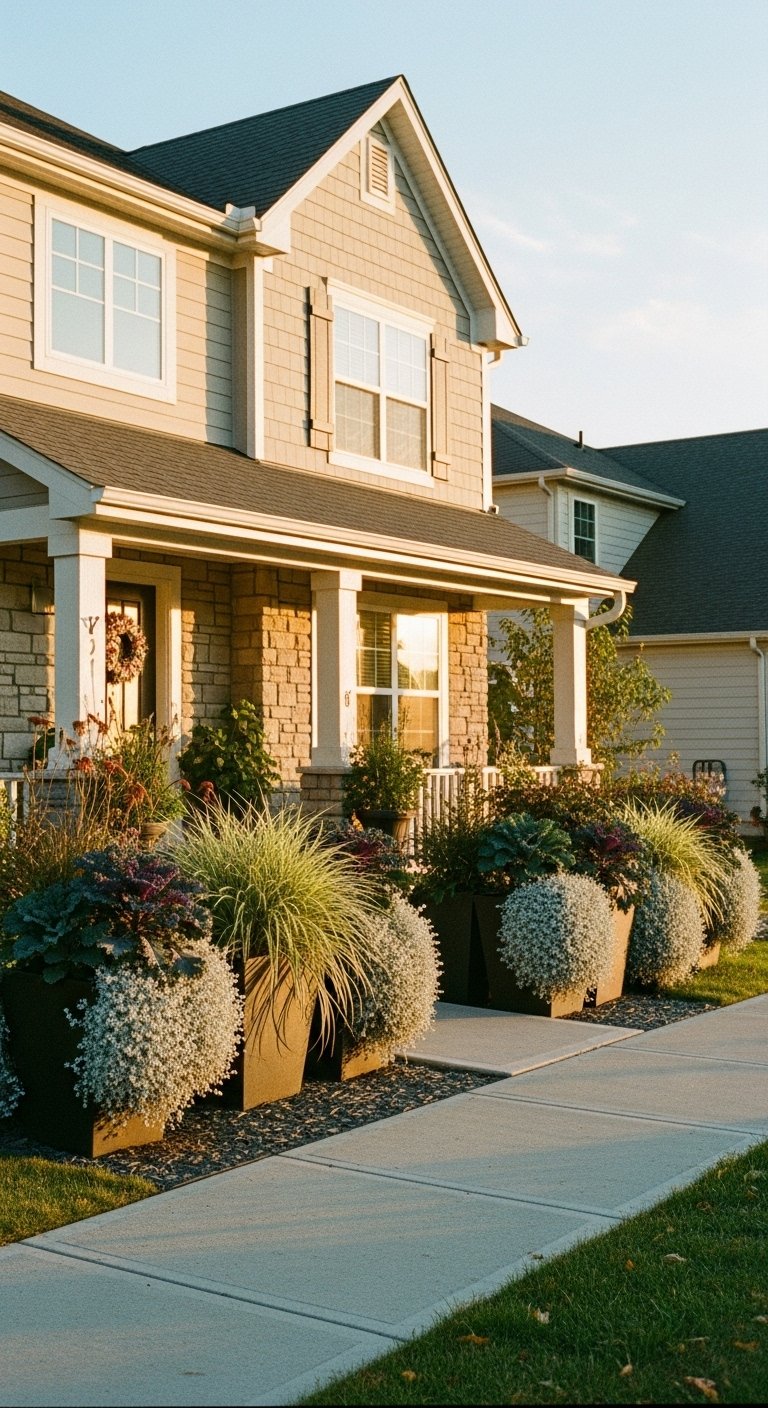Unlock the art of Creating Stunning Fall Planters with our expert tips. Transform your garden with vibrant autumn hues. Save this article now for breathtaking results!
Redefining the Fall Planter
Your outdoor pots can become like little art pieces. They show off what fall feels like—warm days turning into cool nights, and plants growing one last time before they rest for winter. They do it all in a pretty way.
We’re discussing how plants can look and feel cool. These planters fit perfectly by the garage or on their own in the garden. They don’t just make it through fall—they really shine during it.
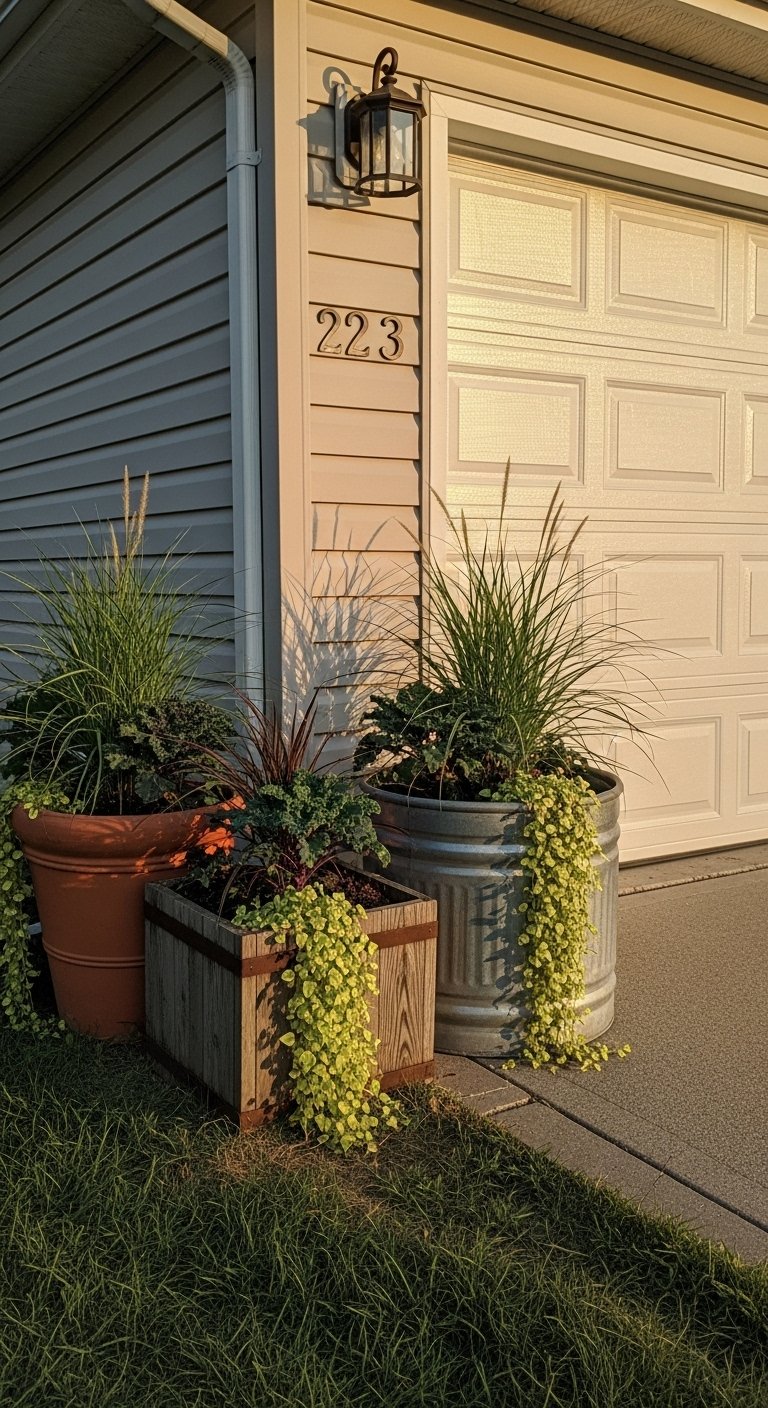
The Core Ethos: Capturing Seasonal Transition
Essence
A perfect fall planter isn’t just the end of summer. It’s also not the start of winter. It’s a special in-between moment, showing us what autumn is all about.
Fall is special because of little things. The warm sun feels nice on your face in the afternoon. At night, the air is chilly. Gardens are full of fruits and veggies. Plants quietly know that it’s time for a change.
Your pots should show everything autumn means.
Core Principles
What’s most important is how things are put together, not just how they look. Pick plants that have interesting shapes. They’ll still look nice even when the frost makes them crunchy. One tall grass plant can stand out more than lots of droopy flowers.
Texture is like a new friend for your plants. Imagine soft leaves beside fuzzy ones, and tiny leaves next to strong stems. Some parts might be shiny while others are not. When you mix all these together, your planters start to look like they are alive.
Choose plants that are strong and graceful. Some keep their colors even when it gets cold, while others change and become like pretty statues. Both kinds make your fall planters special.
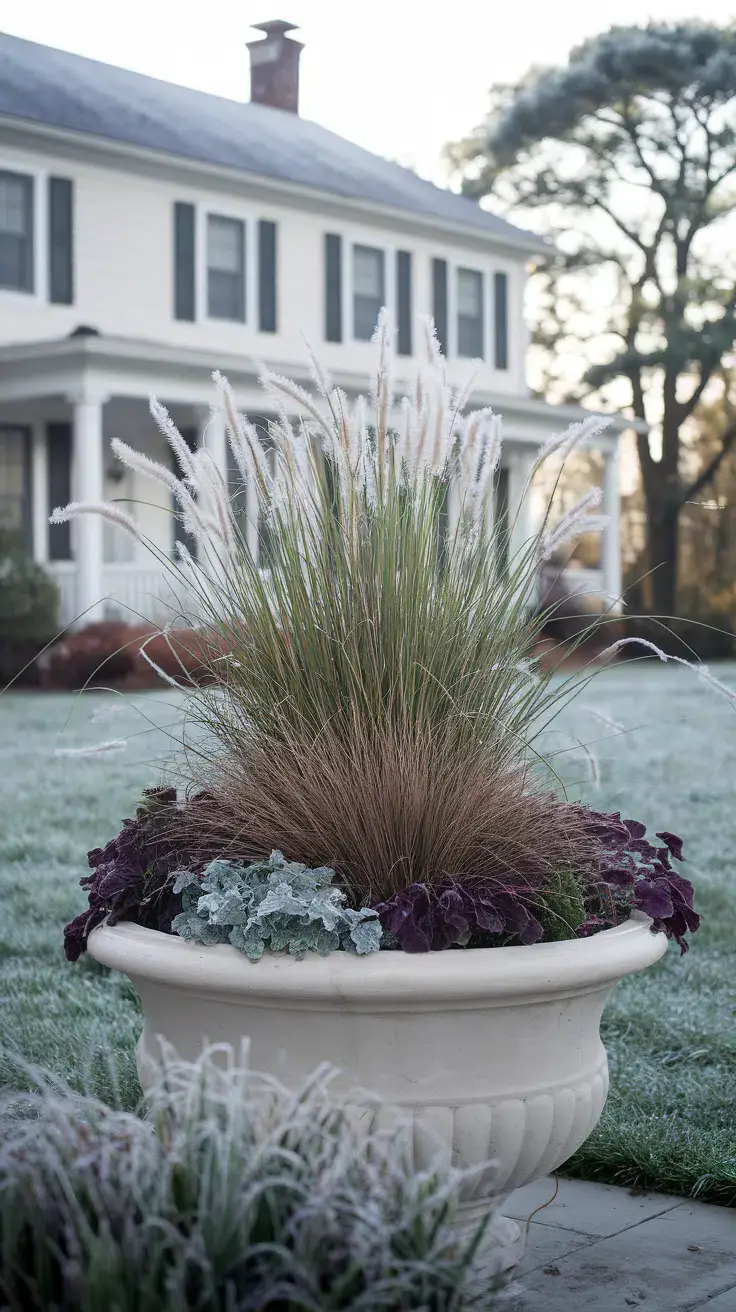
Deconstructing the Masterpiece: The “Tapestry” Method
Rethinking “Thriller, Filler, Spiller”
Most people know about using different plants to make a pot look good. But let’s try something new and clever. Think of it as creating a “Tapestry,” where all the plants come together like a beautiful, living picture.
Imagine your fall planters as a story. Instead of just a simple plant, think about plants like bronze fennel dancing in the wind or purple fountain grass that rustles when the breeze blows. These plants make your garden exciting and different, almost like a great adventure.
The Weave steps in for the fillers. Medium-sized plants help everything fit nicely together. Instead of just filling spaces, they help different colors and textures talk to one another. Pretty cabbage looks nice next to the silvery dusty miller. The dark heuchera makes the bright mums stand out even more.
Imagine the Cascade as a gentle hug around the edges of the planter. Sweet potato vine is a favorite, like a comfy blanket. But maybe try red creeping thyme or silver dichondra for a touch of surprise and beauty.
Choosing Your Vessel
The pot you pick is really important. What it’s made of can make a big difference.
Terracotta pots help plants breathe better, but they might crack in the cold. Fiberstone looks like terracotta but is stronger. Metal pots look cool and modern but can get too hot for the plants. Wood pots are cozy and keep the plants safe from hot and cold weather.
The size of the pot changes things a lot. Big pots stand out by the door and make you look twice. Smaller pots grouped together feel cozy and friendly. Planter boxes near the garage make the building look nicer.

Sophisticated & Fresh Plant Palettes
Palette 1: Burnished Bronze & Deep Burgundy
Begin with the bronze fennel, which is like a soft, feathery plant that glows in sunlight. Or choose the ‘Fireworks’ pennisetum grass, where each leaf looks like it has been painted with a touch of dark red.
Mix in ‘Palace Purple’ heuchera to add some shadowy tones. Its leaves are dark like night in shade and wine-colored in the sun. Use purple cabbage, the fancy ‘Redbor’ kind with ruffled edges, to make it interesting. Bronze-colored mums fill in the middle nicely without looking like they’re just from the store.
Start with the ‘Blackie’ sweet potato vine. Its dark leaves spill over and look mysterious. Add red creeping thyme, which softly drapes over and brings tiny flowers along.
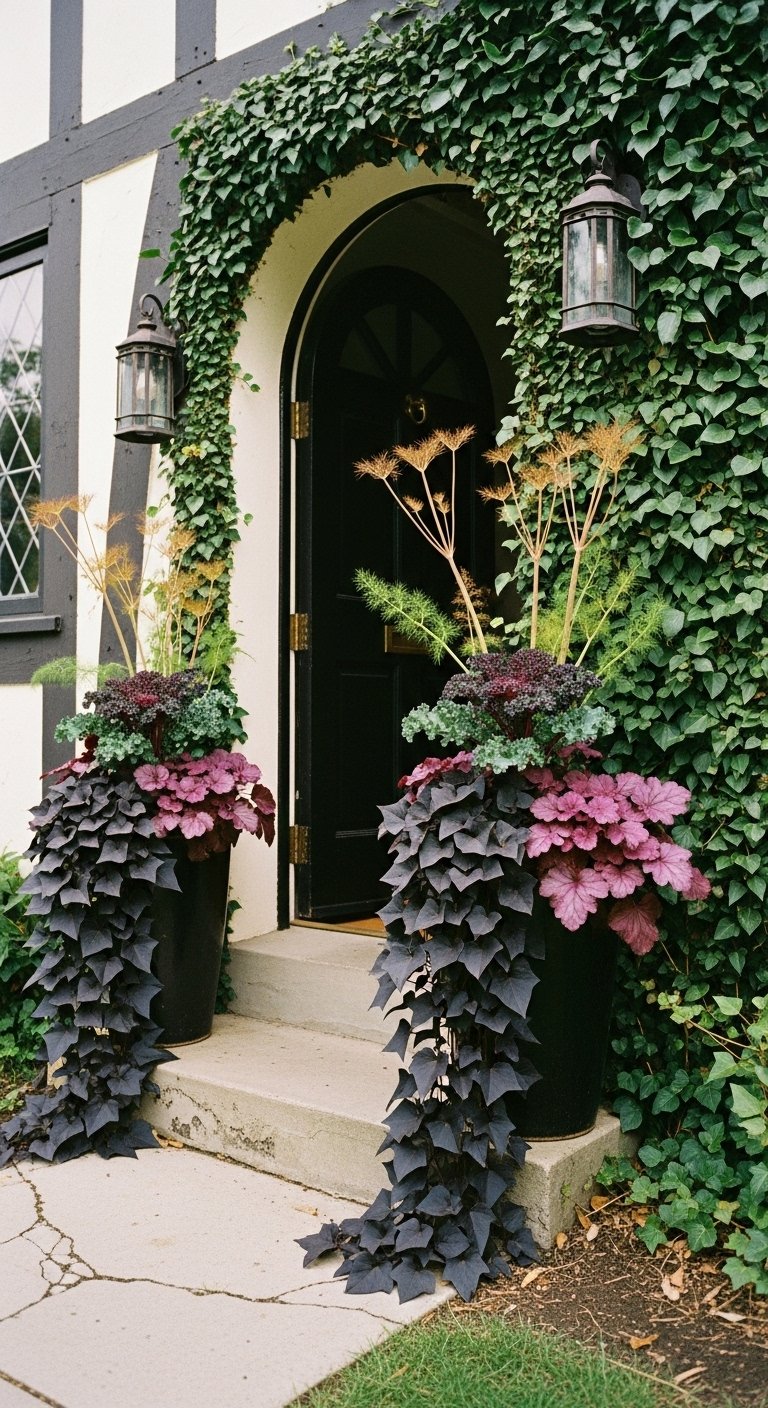
Palette 2: Harvest Moon Glow
Think of ‘Karl Foerster’ grass like tall, straight soldiers keeping watch. In the autumn, its golden tops shine like wheat. The hinoki cypress, a tree that stays green when it’s cold, adds a strong shape and stays nice all winter.
Use dusty miller’s silvery leaves to start your garden. They look soft and shiny like moonlight on velvet. Add cream-colored mums that match the tall grass. Variegated sage adds a hint of purple and smells nice and fresh.
Dichondra ‘Silver Falls’ drapes like a silver waterfall over the edges of pots. Creeping jenny adds a bright green splash for more color.
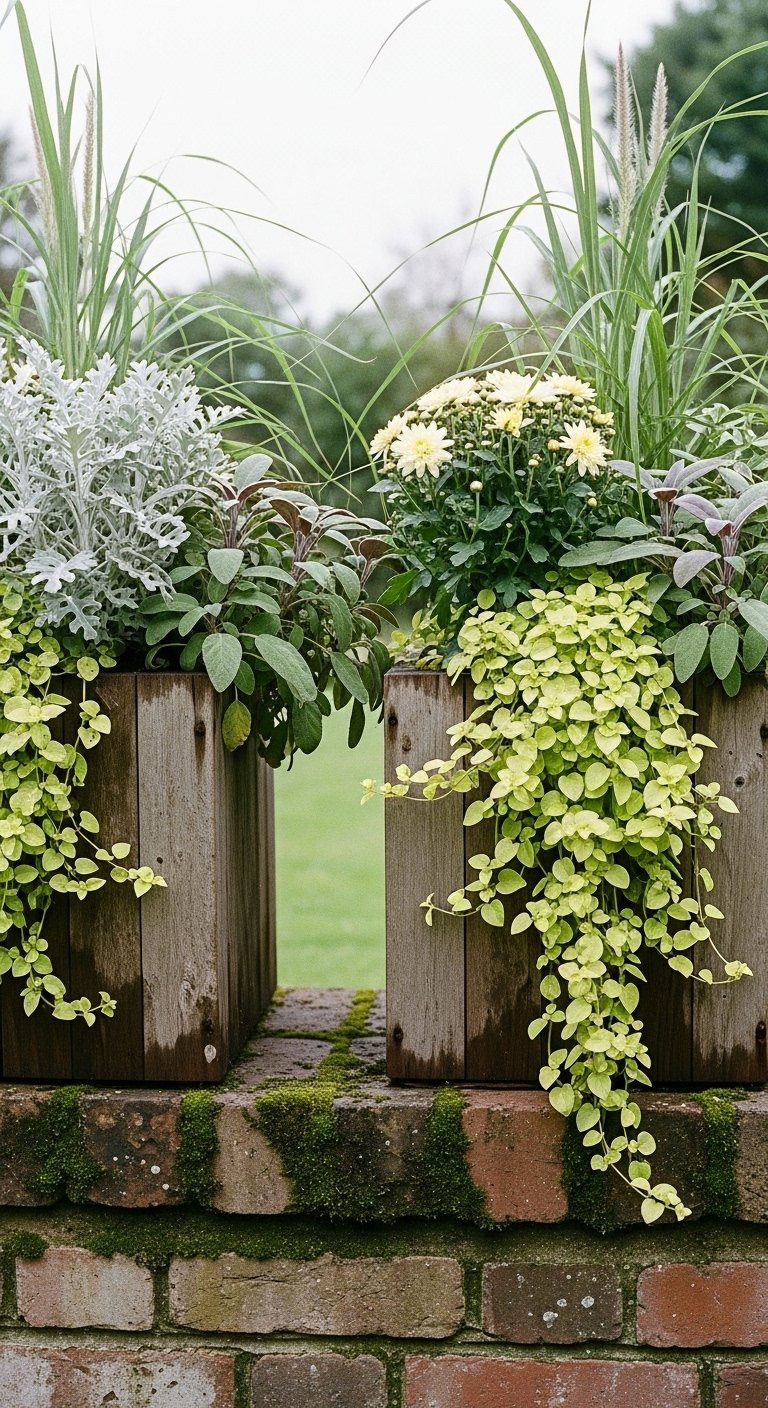
Palette 3: The Painter’s Palette
Who says vegetables can’t be the main characters? Swiss chard ‘Bright Lights’ stands out with its bright pink, orange, and yellow stems like a pack of colorful markers. Next to it, the purple fountain grass sways gently, adding some dance.
In fall, make a planter that really stands out. Combine flowering kale in colors from white to dark purple. Add celosia for a soft, velvety feel. Bright pink asters add a fun take on usual fall flowers.
Variegated vinca minor gently drapes down, its cream and green leaves mirroring the patterns on the chard’s bright stems.
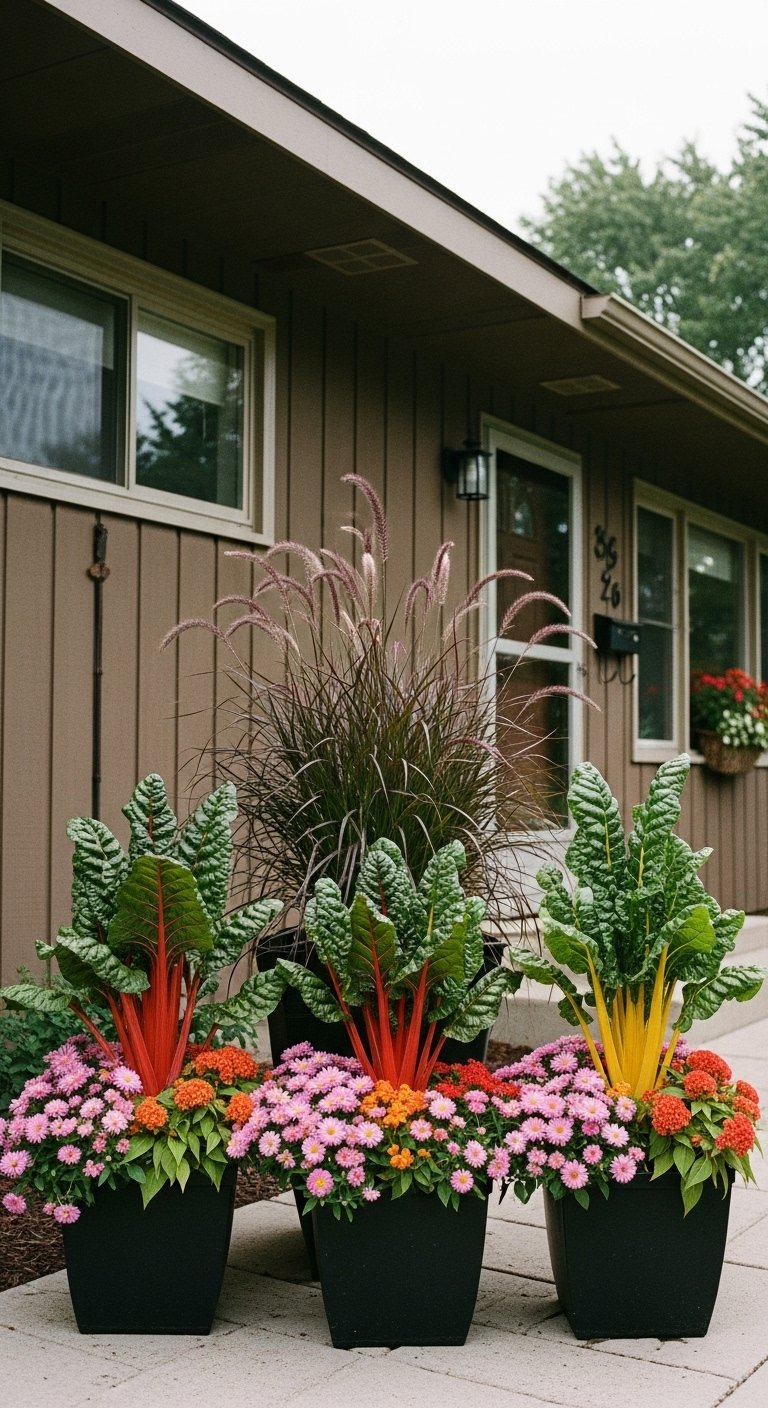
Exploring the Influence of Unique Textures Beyond the Bloom
Grasses and Sedges
Plants make a garden come alive. Japanese forest grass looks like a flowing green waterfall. Little bluestem grass changes to a pretty copper-orange in fall. Carex ‘Evergold’ is always nice to look at and doesn’t need much work.
Different kinds of grass add their own special touch. Some make a soft sound when the wind blows, while others stay strong even in the cold. Having tall and short grasses together will make your garden more interesting.
Seed Heads & Stems
Leave some flowers as they are when they wilt. Echinacea has dark cones that look cool even after blooming. Sedum ‘Autumn Joy’ changes colors from pink to rusty orange and then brown, and it looks nice all the time. Alliums, when they finish flowering, leave round shapes that look lovely with frost or snow on them.
These plants connect the seasons in a natural way. They look beautiful in October, stand out in November, and make cool shapes when covered in December snow.
The Beauty of Bare Branches
Twisting willow branches grow up like nature’s handwriting. The red-twig dogwood adds color when other things turn dull. Harry Lauder’s walking stick makes fun shapes in the winter sky.
Branches stay fresh for months without any effort when placed in containers. They don’t need water or looking after, just being their cool and interesting selves.
Artificial Enhancements
Sometimes, we need colors we can trust. Fake plants can help make things look nice. Add a few pretend maple leaves with real ones. If the real flowers didn’t work, put in a fake mum.
The trick is to be careful. Use fake plants as little decorations, not the main stars. Mix them in well with the real plants, and no one will guess your secret.

Smart Strategies: The Budget-Friendly & DIY Fall Planter
Forage Your Garden
Your garden has little treasures waiting for you. To create fall planters without spending much, begin with the plants you already have.
Hostas can seem a bit worn out in the garden, but their leaves really glow when put in pots. If you cut them before the frost comes, they’ll stay nice for weeks. You can split up ornamental grasses for free, and sedum cuttings will happily grow roots in pot soil.
Look around your garden like it’s brand new. See that big sage plant? It’s just right for putting in pots. And if your heuchera is taking over, you can share it by splitting it up and popping it into containers.
The “Pot-in-Pot” Method
Here’s a new trick for creating budget-friendly fall planters. Keep the plants in their original pots, then place them into bigger containers filled with mulch or dirt.
Change the plants when the seasons change. The roots stay safe, and they don’t get upset. Your fall plant pot looks nice without much work.
Focus on Foliage
Flowers disappear quickly in the fall, but leaves stick around. Think of them as a long-term friend. Ornamental kale costs the same as mums but stays much longer. Heuchera keeps its color from September all the way to March.
A really strong plant with nice leaves is better than having lots of okay flowers.
DIY Planter Boxes
Making fall planters is easy and fun; you don’t need to be an expert builder. Just grab four old pieces of wood, some screws, and make a few holes for water to drain out. That’s it!
Cedar fence pickets work well for making cheap sides for planters. You can take apart old pallets to create cool, old-style boxes. If you stack concrete blocks in a fun way, they turn into modern planters.
You should line your wooden planters with plastic to help them last longer. Put wheels on them so you can move them around easily. You can paint them in fun colors or just enjoy how they look naturally—both ways are nice.
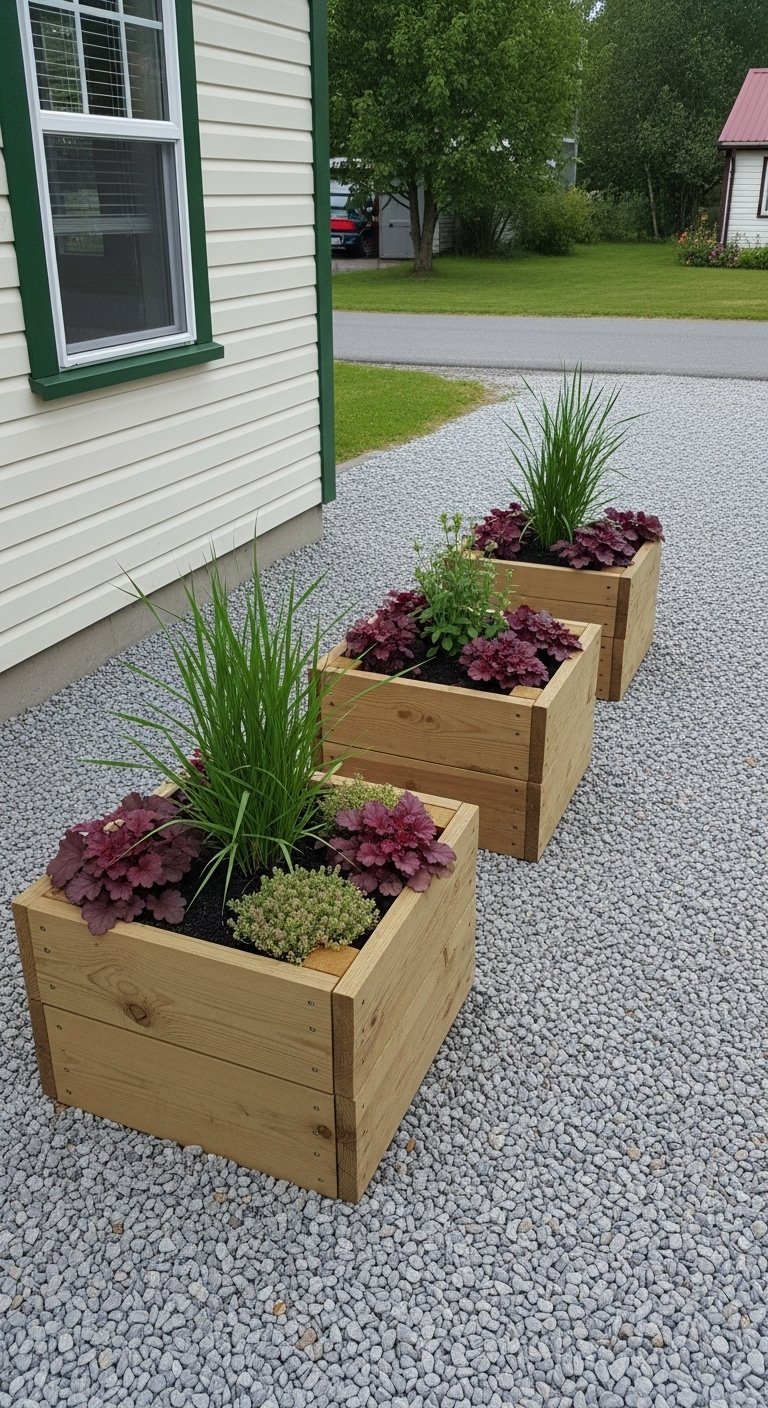
Assembly & Long-Term Care
Step-by-Step Planting Guide
Begin with drainage. Even in fall and winter, your plants need extra water to leave the pot. Put two inches of gravel or broken pottery at the bottom of your container. If you skip this, the roots might get too wet and rot by November.
Use good potting soil, not the kind from the garden, because garden soil can get too tight and squeeze the plant roots. Add some slow-release fertilizer to make sure your plants have enough food to grow and look nice in the fall.
Start by planting your main plant first. Place it a little bit away from the middle so it looks more interesting. Press the soil around its roots to keep it steady. This plant is important for your design, so make sure it stands strong.
Next, put in your weave plants. Make them different heights and angles. Don’t have them all standing straight up. Tilt a few so they point outward. Let others bend toward the center. Nature isn’t neat and tidy.
To finish, add the cascade plants around the edges. Plant them tilted, so they look like they’re already flowing over. This helps them hang down nicely, like a waterfall.
Give your plants a good drink of water until you see it coming out of the bottom holes. The soil will sink down a bit after this. If there’s too much space, put in a little more soil to keep it level with the top, but don’t let it pile up.
Watering as Weather Cools
In autumn, even skilled gardeners find it tricky to know how much to water. Plants don’t need as much water when it gets colder, but they do need a bit. If the soil gets too dry and then it freezes, the roots might die.
Every week, have a look at your plant pots. Push your finger in about two inches. If the soil feels damp, you can wait. If it’s dry, it’s time to give them some water. Easy peasy.
In the fall, it’s a good idea to water your plants in the morning. This gives them time to soak up the water before the chilly nights come. When leaves stay wet at night, they can get sick.
Editing Your Planter
Some plants wilt nicely, while others just look messy. It’s important to notice which is which and then do what’s needed.
Take away the really dead stuff, like brown flowers. Pull those out. But leave the tall grass and the heads of sedum plants. They make the garden look nice during winter.
You can fill the empty spaces with cut branches or little evergreen twigs. Pine, cedar, or juniper are great because they stay green all winter long even though they don’t have roots.
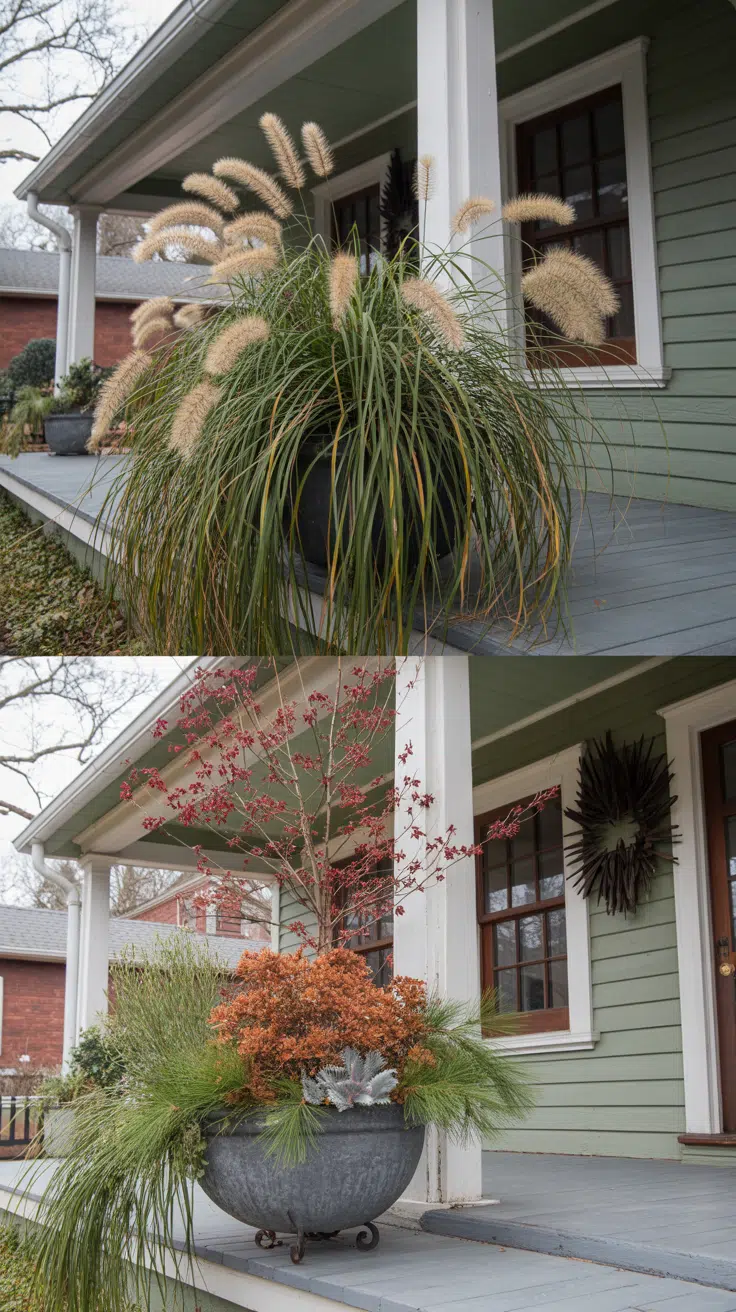
Your Fall Declaration
You’ve learned to notice more than just the usual orange flowers and tiny pumpkins. Your fall pots can be much more interesting than these typical things.
Always keep the basics in mind. Having a good setup is always better than just being flashy. When flowers stop blooming, different textures make things exciting. Strong, long-lasting plants keep your garden looking nice season after season.
The tapestry method is like a guide, not a strict list of rules. Taller plants act like the main characters, adding height and action. Other plants help everything come together like a woven story. Hanging plants soften the edges around things. But sometimes, breaking the rules is fun too. Just one tall grass in a plain pot can be perfect on its own.
Having a small budget doesn’t stop you from being creative. There are so many things you can do in your garden. Thrift stores have cheap containers. Making your own planters from old wood is nearly free. Beautiful fall planters are all about using your imagination, not spending money.
Your plant pots should show what you like. If you love bright colors, plant Swiss chard and hot pink flowers. If you like things calm and pretty, use silver and cream plants. If you want easy care, choose grasses and evergreen plants.
Fall planters are like a snapshot of a special time in the year. They show the change from busy, growing summer days to quiet winter times. It’s like holding onto the moment when things start to slow down.
Your home’s entrance should look special, not plain and boring. Adding fall planter boxes by the garage can brighten up places people usually don’t notice. The plants on your porch can even make neighbors pause to admire them.
Put on your gloves. Pick some pots. Choose the plants that you really like.
Make something pretty. Make something that’s yours. Show off your fall style.
The season is ready.
